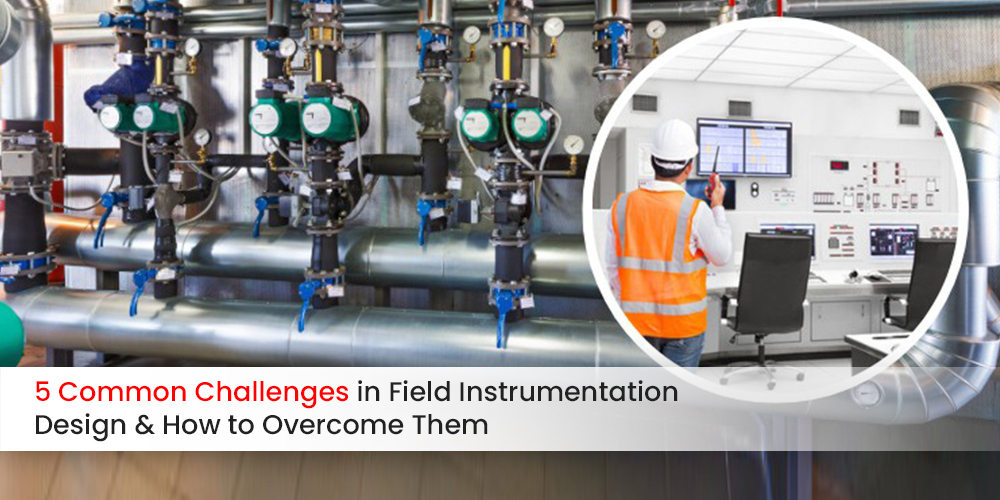5 Common Challenges in Field Instrumentation Design and How to Overcome Them
- August 24, 2024
- Posted by: Waman Sanap
- Category: Uncategorized

Field instrumentation forms the backbone of any industrial process, providing real-time data for monitoring and control. However, designing effective field instrumentation systems comes with its own set of challenges. Here, we explore five common hurdles faced during the design process and strategies to overcome them:
Challenge 1: Specifying the Right Instruments
Problem: Selecting the most suitable instruments for a specific application requires a deep understanding of process parameters, environmental conditions, and desired accuracy. Choosing the wrong instrument can lead to inaccurate readings, reduced process efficiency, and even safety hazards.
Solution:
- Thorough Process Understanding: Close collaboration between process engineers and instrumentation specialists is crucial. A detailed understanding of the process, including pressure, temperature, flow rates, and fluid properties, allows for the selection of instruments with appropriate measurement ranges and sensitivities.
- Environmental Considerations: Consider the surrounding environment, including temperature extremes, vibration, and corrosive atmospheres. Ruggedized instruments or protective enclosures may be necessary for harsh conditions.
- Industry Standards and Regulations: Ensure compliance with relevant industry standards and safety regulations when selecting instruments. Specific industries, like Oil & Gas or Pharma, may have additional requirements.
- Life Cycle Cost Analysis: Consider not just the initial cost of the instrument, but also installation, maintenance, and calibration expenses over its lifespan.
Challenge 2: Ensuring Clear and Accurate Documentation
Problem: Ambiguous or incomplete instrument documentation can lead to installation errors, commissioning delays, and difficulties during maintenance.
Solution:
- Standardized Documentation Practices: Implement standardized templates and formats for instrument specifications, data sheets, and loop diagrams. This ensures clarity and consistency throughout the project.
- Detailed Drawings and Schematics: Provide clear and comprehensive drawings illustrating instrument location, piping connections, wiring schematics, and control panel layouts.
- Software Tools: Utilize dedicated software for instrument design and data management. These tools can automate tasks, improve accuracy, and facilitate collaboration.
Challenge 3: Managing Interface Between Instrumentation and Control Systems
Problem: Field instruments need to seamlessly integrate with the control system for data acquisition and process control. Communication protocols, data formats, and signal integrity all need careful consideration.
Solution:
- Standardized Communication Protocols: Select industry-standard communication protocols like HART, Modbus, or Profibus to ensure compatibility between instruments and control systems.
- Data Format Consistency: Establish consistent data formats for all instruments to avoid errors during data transmission and processing.
- Signal Integrity Measures: Implement appropriate grounding and shielding techniques to prevent signal interference and ensure accurate data transmission.
Challenge 4: Integrating with Existing Infrastructure
Problem: New or upgraded instrumentation needs to integrate seamlessly with existing plant infrastructure, including piping, power supply, and cable trays. Modifications or expansions may be necessary.
Solution:
- Inventory and As-Built Drawings: Carefully review existing plant documentation, including inventory lists and as-built drawings, to understand the existing infrastructure.
- Space Considerations: Ensure adequate space is available for new instruments, control panels, and cabling during installation.
- Compatibility with Existing Systems: Choose instruments that are compatible with existing piping materials, power supply voltages, and existing control system architecture.
Challenge 5: Ensuring Maintainability and Future Needs
Problem: Inefficient instrument layout or poor accessibility can complicate future maintenance and calibration activities. Additionally, future process modifications may require instrument upgrades or additions.
Solution:
- Accessibility and Maintainability: Design instrument layouts with easy access for maintenance activities like calibration, replacement, and troubleshooting.
- Standardization and Modular Design: Promote standardization of instrumentation types and modules to streamline future maintenance and facilitate interchangeability.
- Scalability and Flexibility: Consider potential future plant expansions or process modifications when designing the instrumentation system. Allow room for future instrument additions or upgrades.
Conclusion
By recognizing these common challenges and implementing the suggested solutions, you can ensure that your field instrumentation design is efficient, reliable, and future-proof. Working with experienced instrumentation specialists like iPAC Automation (link: https://ipacautomation.com/service/field-instrument-detailing-and-designing/) can provide the necessary expertise and support to navigate these challenges and deliver a successful instrumentation design project.

Waman Sanap is the CEO of iPAC Automation, a leading instrumentation and control automation company. He has 20+ years of experience in the instrumentation engineering field.
